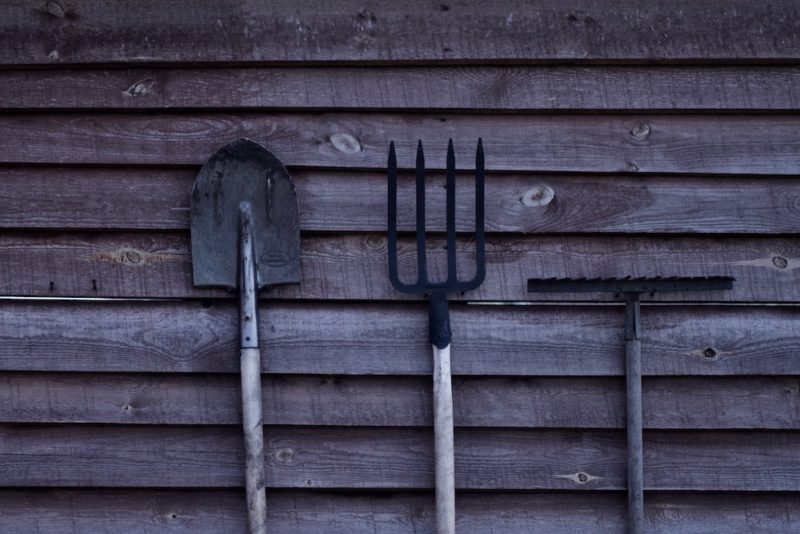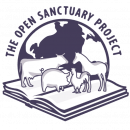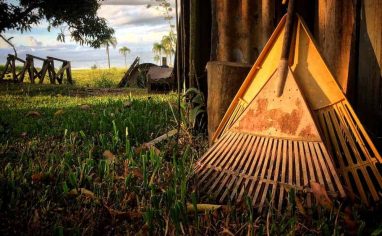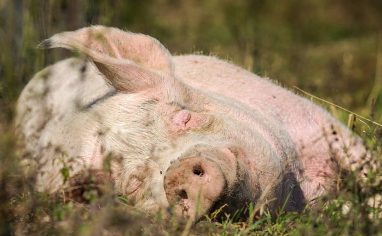
This resource was fully reviewed and updatedA member of The Open Sanctuary Project’s staff has given this resource a full review and provided updates where necessary. by a member of The Open Sanctuary Project as of October 27, 2025. It was originally published on April 15, 2018.
Cleaning and maintenance of living spaces are important aspects of caring for turkeysUnless explicitly mentioned, we are referring to domesticated turkey breeds, not wild turkeys, who may have unique needs not covered by this resource.. Providing a clean living space can help prevent illness, and regular maintenance will keep the space safe for both the turkeyUnless explicitly mentioned, we are referring to domesticated turkey breeds, not wild turkeys, who may have unique needs not covered by this resource. residents and their human caregivers.
Create And Maintain A Cleaning Schedule
To keep resident living spaces clean, while being mindful of resources such as bedding, cleaning supplies, and caregiverSomeone who provides daily care, specifically for animal residents at an animal sanctuary, shelter, or rescue. time, it often works well to do daily spot cleanings, regularly scheduled full cleanings, and semi-annual deep cleanings. Depending on the specifics of your sanctuary and who is responsible for cleaning, it may be helpful to create a (semi-) set schedule to ensure folks know what cleaning tasks are due each day and to ensure your daily schedule is not overbooked. When first determining how often spaces need to be fully cleaned and what areas require daily spot cleaning, it can be helpful to spend a few weeks tracking what cleaning tasks need to be done each day. After a few weeks of doing this, look back over this information for trends. Do certain areas need to be addressed daily? Every-over-day? Weekly? How many days can you reasonably go between full cleanings while maintaining your cleaning standards? You can then use this information to create a cleaning schedule and budget time accordingly. For example, you may determine that so long as nesting and roosting areas are cleaned daily, you can do full cleanings once each week. If you can’t detect a pattern or if you prefer to tailor your daily cleaning schedule based on exact needs, you can continue checking the space daily and cleaning as needed.
Adjust As Needed!
Set schedules can be super helpful when determining how to best divvy up daily responsibilities and schedule in less frequent tasks without overloading anyone. However, it’s important to remain flexible. As various factors change, you may find you need to adjust the schedule, and there may be times when something unexpected happens and the space needs more attention than you planned. We’ll discuss this more below.
When establishing cleaning schedules, keep the following in mind:
- Certain areas may need to be cleaned more often than others, and this is where spot cleaning comes in. When spot cleaning, you focus on the dirty areas of the living spaceThe indoor or outdoor area where an animal resident lives, eats, and rests. only. In turkey living spaces, nesting and roosting areas (or the area under perches and dropping boards, if used) will need to be cleaned frequently (often daily). Other areas that may require more frequent cleaning include around drinking water vessels and near entrances.
- How often the indoor space needs a full cleaning (where the entire space is cleaned and all bedding is removed) will depend on several factors, including the number of residents, how much space they have, and how much time they spend indoors. Keep in mind that the amount of time they spend indoors may change seasonally, especially if different seasons bring very different weather conditions. For example, you may find that during cold weather, your turkey residents spend significantly more time indoors during the day than they do when the weather is warmer. Therefore, full cleanings may need to be scheduled more frequently in the winter than in the summer. As mentioned above, be prepared to adjust cleaning schedules as needs change.
- If you have daily responsibilities split up between multiple shifts, be sure to consider which specific tasks are part of the shift responsible for cleaning living spaces. For example, water and food dishes should be cleaned daily. Does the person cleaning the living space have to do this? Or is it the responsibility of the person who feeds the residents? Being clear about who is responsible for what is crucial to avoid confusion and tasks being missed.
- Regardless of your cleaning schedule, if bedding becomes wet, it must be replaced. This may occur if precipitation blows into the space through open doors or windows or if residents or humans track mud or snow into the living space. Additionally, things like spilled or leaking water vessels can lead to wet bedding. We recommend carefully checking around water vessels for wet bedding daily. In some cases, the top layer of bedding may appear dry, but further inspection reveals soaked bedding below. Wet bedding can lead to foot issues and create humid conditions, so it’s important to address wet areas as soon as possible.
- Just as wet bedding must be addressed daily, so too should any spilled food. Whether it is indoors or outside, spilled food will attract rodents and other wildlife. Rats can cause serious, and even fatal, injury to turkeys, so you must avoid practices that will attract them (and take steps to deter them).
Below, we’ll take a look at what cleaning of turkey living spaces may entail, though the specifics will vary depending on a sanctuary’s specific setup, resident population, climate, etc.
Spot Cleaning
To keep spaces clean between full cleanings, take time to tackle the areas that need the most frequent cleaning more regularly. During spot cleaning, you can also address unexpected areas that require attention.
In turkey living spaces, spot cleaning may entail addressing the following areas:
- Perches/Roosts – Remove and replace soiled bedding from the top of roosts and/or from underneath perches. Use a stall deodorizer as needed. If you use a dropping board, use a scraper to remove caked-on droppings.
- Nesting Areas – Check all nesting nooks. Collect eggs and remove any soiled bedding, replacing with fresh as needed. If an egg has been broken in a nesting area, remove all bedding, thoroughly clean surfaces, and replace it with new bedding. Especially in warm weather, it’s also a good idea to check your residents to make sure no one is coated in egg, which could attract flies.
- Check Around Drinking Water – Check the bedding around drinking water vessels to ensure it is dry. Remember that the top layer of bedding may look dry, so use your foot or a cleaning tool to move bedding and look for wetness. Remove and replace bedding as needed. If you find wet bedding, be sure to investigate the water vessel to see if there is an issue. Of particular note, gravity-fed units may leak if they are not level.
- Address Other Areas As Needed – If there are other areas of the living space that have been identified as needing more frequent cleaning, be sure to address these. Then do a quick visual inspection of the rest of the space and address any other areas that are particularly dirty, even if they don’t typically need frequent cleaning.
Full/Total Cleaning
Spot cleanings have their place, but you should also fully clean out the living space regularly (for example, weekly).
When fully cleaning turkey living spaces, be sure to:
- Remove all bedding, apply a stall deodorizer, and add fresh bedding. Depending on the type of bedding you use and the substrate in the space, you may need to sweep up dust and small bits of bedding and/or use a scraper tool to remove caked-on droppings from the floor.
- Clean nesting/perching areas as described above.
- If you are using stall mats, be sure to remove and clean under them regularly.
- If you use straw bales for nesting or roosting areas, move them regularly to ensure rodents aren’t nesting in/under them. Replace as needed.
- Dust fans, ledges, and other surfaces to promote healthier air quality (this is best done after putting down fresh bedding).
- As part of your fire prevention strategies, remove dust, cobwebs, and other debris that may accumulate on electrical appliances (including but not limited to heating devices), lights, and outlets.
- The cleaning process can result in bedding ending up in water sources, so even if cleaning drinking water is not part of your living space cleaning responsibilities, be sure to check waters and remove bedding or dump and refill water as needed. It’s a good idea to clean these after new bedding has been added to the space.
- If your residents have man-made dust baths, check and refill these regularly.
- While it’s not typically feasible or necessary to clean large, grassy, outdoor spaces, if your residents spend time in smaller spaces or spend a lot of time in dirt areas, regularly removing droppings from these areas may be necessary.
Further Reading
Wondering what to do with all that poop? Check out our introductions to manure management and composting for more information.
Deep Cleaning
In addition to routine cleaning, be sure to schedule a few deep cleanings each year. This is the time to clean the entire space even more thoroughly, which may include the following:
- Removing nest boxes to thoroughly clean and disinfect and to clean behind them (this is also a good time to check for developing breaches that may be concealed by larger nest boxes.
- Thoroughly cleaning and refilling dust baths.
- Dusting and removing cobwebs in hard-to-reach areas that are difficult to do regularly (this includes using a compressed air blow gun to remove dust from appliances with many nooks and crannies if necessary).
- Cleaning windows and screens.
- Wiping down doors.
- Disinfecting surfaces.
Keep The Weather In Mind When Scheduling Cleaning And Maintenance
Avoid projects that require locking residents out of their indoor spaces during uncomfortable weather. This may mean scheduling projects for early morning, before temperatures heat up in the summer, or finding a way to clean spaces without restricting your residents’ access to the space during cold, blustery weather.
Cleaning Supplies
Suggested supplies for living space cleaning include:
- Pitchfork, rake, and/or shovel to remove bedding.
- Broom and dustpan to sweep up dust and small bits of bedding. A broom can also come in handy when cobweb dusting hard-to-reach corners.
- Non-toxic stall deodorizer. Avoid using hydrated lime as a stall deodorizer – it’s not safe for you or your residents to breathe it in, and it can also cause skin and eye irritation.
- Large buckets to hold old/soiled bedding.
- Long-handled duster to dust circulation fans, exhaust fans, and other electrical devices.
- Animal-safe disinfectant or cleaner, such as dilute chlorhexidine or Bac-Out, to clean non-porous surfaces.
- Cloth rags to wipe down ledges, window sills, fans, etc.
- Paint scraper or putty knife to scrape droppings from hard surfaces such as walls or ledges.
- Bucket to collect eggs.
- Face masks to prevent dust inhalation.
For more helpful supplies to consider keeping on hand, check out our supply checklist resource here!
Maintenance
You should always be on the lookout for areas of the habitat in need of maintenance so you can address issues in a timely manner, but some maintenance issues are most apparent when bedding is removed, so be sure to closely examine the living space during regular and deep cleanings. While this should not be the only time you look for damage that could lead to a breach in the space’s predator-proofing, you may be able to detect issues when bedding is removed that you otherwise would not see. Be sure to keep predator protection in mind when looking for maintenance issues. Anything issues that could allow predators into the space (or residents to leave the space) must be addressed immediately.
While there are a variety of things that can break or otherwise require maintenance, the following are of particular note:
- Floors should be inspected for damage. Wood floors should be checked for signs of warping, rot, or damage from chewing. To ensure continued predator protection, these issues must be addressed immediately. If you have dirt floors or a layer of dirt over concrete, watch for developing divots or the dirt becoming so firmly packed that it no longer provides adequate cushioning. Fill divots in with new dirt and top hard-packed dirt floors with fresh dirt to restore cushioning.
- Check nesting areas and perches for signs of damage. As mentioned above, you should also check for breaches underneath or behind nest boxes and roosts.
- Inspect any heating and cooling systems prior to the time at which you typically need them (i.e., inspect all circulating fans before the warm weather hits). This will allow you to fix or replace devices as needed and ensure that you are able to keep residents comfortable. Check these regularly for signs of damage or issues and repair/replace as needed.
- Before cold weather hits, be sure to check the living space for gaps that could create a draft. Also, be sure to check any exhaust fans to ensure the shutters close properly to keep cold air out when not in use.
- Most wood siding will need to be repainted or restained to keep it protected and prolong its life. Be sure to use paints and stains that are safe to use around animals.
- If the structure has metal siding, be aware that this can develop sharp edges when damaged, which will need to be addressed in order to prevent injury.
- Check fencing and other physical infrastructure (such as aviary netting) for signs of damage and repair as needed. In addition to scheduling time to check fences regularly, be sure to inspect them after storms that have the potential to cause damage to them.
- To maintain grassy areas for residents, reseed as needed.
Now that you’ve got an idea of the cleaning and maintenance required, be sure to come up with a plan to keep on top of these tasks. Doing so will help in maintaining your turkey residents’ health, comfort, and safety!








